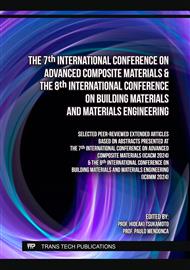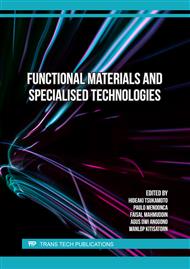p.3
p.11
p.17
p.23
p.33
p.39
p.47
p.55
p.61
Effect of Loading Speed on Tensile Property of Single Flax Yarn/Shellac Green Composite Material
Abstract:
In this study, tensile property of green composite material using single flax yarn and shellac resin under loading speed was investigated for safety of sustainable structural materials. The molding method was compression molding method. Static tensile tests of single flax yarn and green composite material were conducted under constant temperature and humidity room. The test speed was 10-100 mm/min. Following conclusions were obtained. Tensile strength and Young’s modulus of single flax yarn and green composite material increased with an increase of test speed. From fracture observation, large damage of fiber in the green composite material at 10 mm/min and 100 mm/min did not occur after static tensile tests. But damage of fiber in flax yarn was found when static tensile tests of single flax yarns at 10 mm/min and 100 mm/min were conducted. Therefore, the effect of loading speed on tensile property of green composite material might be affected by viscoelasticity of flax fiber and matrix.
Info:
Periodical:
Pages:
33-38
Citation:
Online since:
December 2024
Authors:
Price:
Сopyright:
© 2024 Trans Tech Publications Ltd. All Rights Reserved
Share:
Citation:



